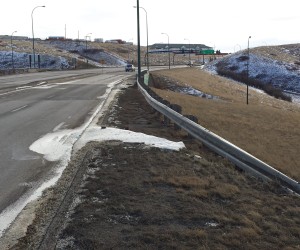The design guidelines for all barriers is taken from the AASHTO Roadside Design Guide.
Determining if Guardrail is Required
It is necessary to calculate a “clear zone” which is a distance from the pavement edge within which there should be no hazards. If a non-breakaway appurtenance must appear within the clear zone, a barrier is required. The size of the clear zone is dependent on traffic volume, design speed, and roadside slope.
Runout Length
The first step is to calculate the runout length. This is defined as the distance from the hazard to the point where a vehicle is assumed to leave the road. Obviously, the longer the runout length, the longer the guardrail, but AASHTO provides the guidance for this value based on traffic volume and the design speed of the roadway.
| Traffic Volume (ADT) | ||||
|---|---|---|---|---|
| > 6000 | 2000 – 6000 | 800 – 2000 | < 800 | |
| Design Speed (mph) |
Runout Length, Lr ft |
Runout Length, Lr ft |
Runout Length, Lr ft |
Runout Length, Lr ft |
| 70 | 480 | 440 | 400 | 360 |
| 60 | 400 | 360 | 330 | 300 |
| 50 | 320 | 290 | 260 | 240 |
| 40 | 240 | 220 | 200 | 180 |
| 30 | 170 | 160 | 140 | 130 |
Guardrail Length
The guardrail length is then chosen based on the intersection of the guardrail with the line connecting the runout length and the far end of the hazard (the clear zone length if it reaches outside the clear zone).
The guardrail at the leeward end is calculated in reverse. The runout length is applied to the opposing traffic lane instead of the adjacent lane, making the guardrail length a bit shorter.


Speak Your Mind